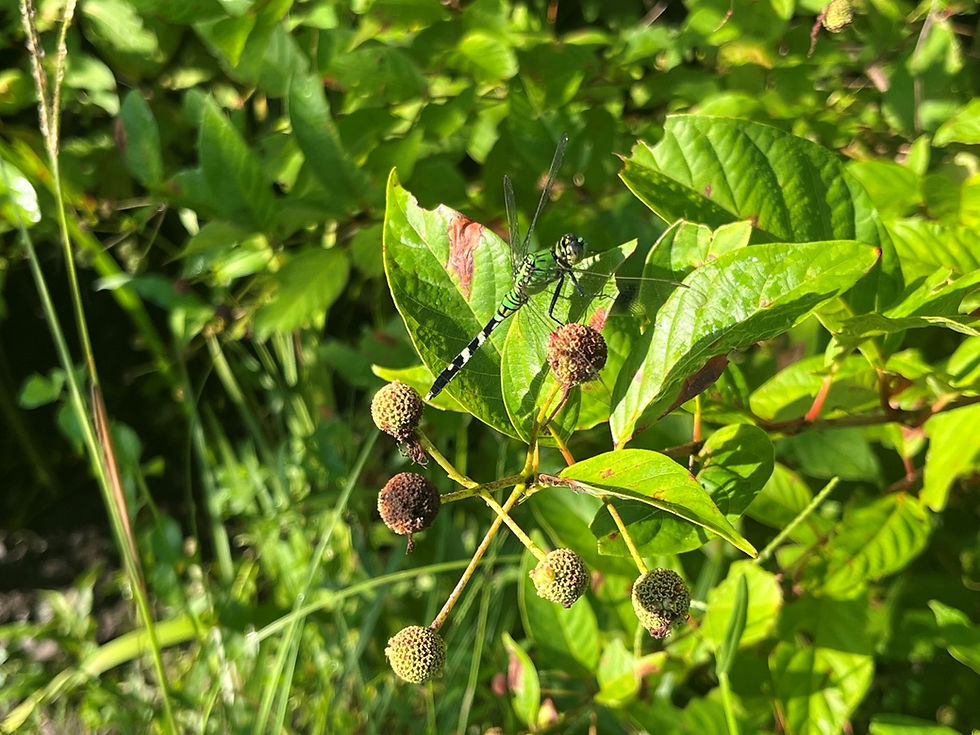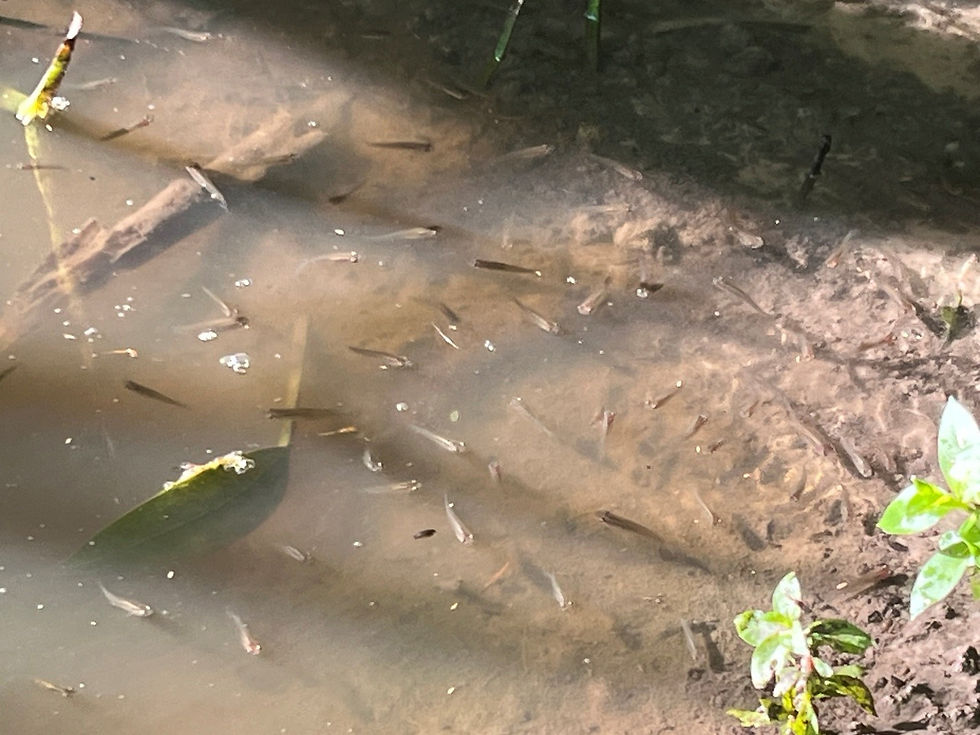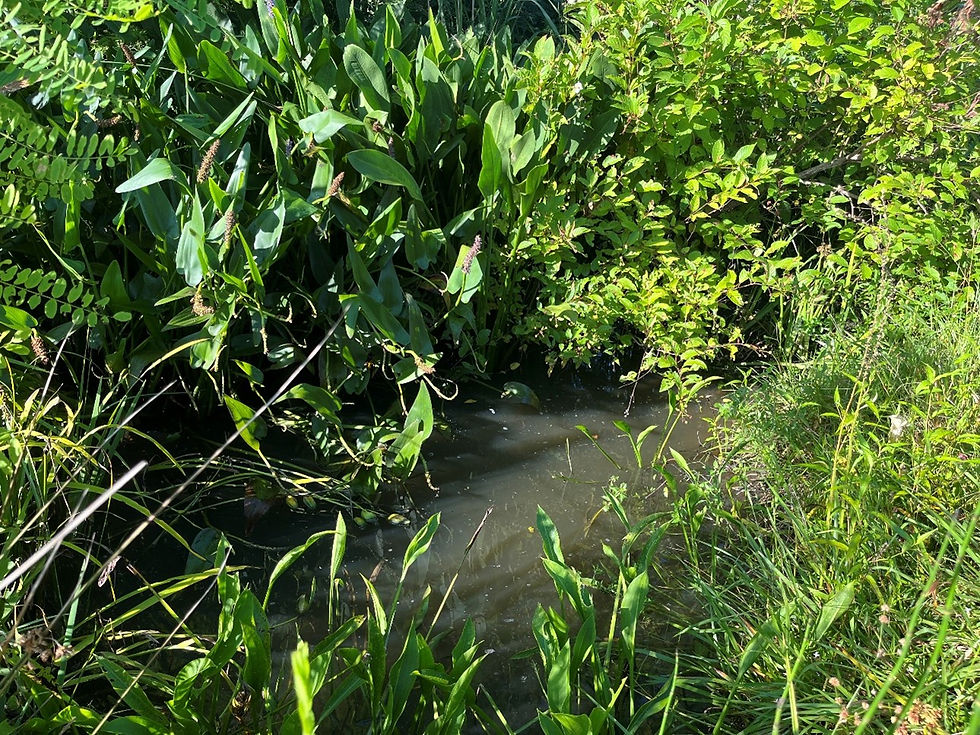Nature-Based Solutions to Keep Mosquitos in Check
- ANPP Volunteers

- Aug 4
- 8 min read
Robby Maxwell
We bought our first home on 2.5 acres in south Louisiana in 2011. It seemed like an idyllic setting, a cute old house with a large yard and huge shade trees. Apparently, mosquitoes also thought it was the perfect place to hold their festivals in the spring and fall, and really any time of year after a good south Louisiana frog strangler. The mosquito swarms could be a real problem. One time, the back door was accidentally left propped open with the living room light on all night leaving the walls black with mosquitoes. On other occasions, we had to rush guests into a darkened house when they arrived after dark, only to spend the first half hour swatting mosquitoes before we could settle in and chat. Sometimes, you couldn’t get within 20 feet of shade in the middle of the day without being swarmed. The parish would spray by road and by air, and nothing really seemed to help other than environmental conditions shifting away from “mosquito overdrive.” The mosquitoes really were as bad as everyone imagines they are in Louisiana. Over the years, we’ve taken steps to use nature-based solutions to reduce the mosquitoes on our property, and have been successful. The following is an example of what works at our property in rural south Louisiana. Just following our recipe might work for you, or maybe you can take ingredients from our experience and make the perfect dish for your situation. If nothing else, maybe this will encourage someone to look at their property as a complex system and not just a static diorama.
In 2017 we planted our first half acre of native locally sourced tallgrass prairie on the property in an area that was particularly muddy from January through May most years. Along with the flood of pollinators, fireflies, and all the other critters that showed up that year, we also noticed a serious boost to our dragonfly and damselfly (collectively known as odonates) population. There’s an irrigation ditch on the east end of the property that is a great source of odonate nymphs, and now that we had more complex habitat, they stuck around to take advantage of it. I began to contact our parish mosquito control about not spraying our property since we were providing habitat for a healthy insect and spider populations that not only pollinate, but also provide mosquito control and other ecosystem functions. I was told they could halt roadside spraying (and driving into our driveway to spray), but we were on a flight path for spraying, and that couldn’t be changed. Hurricane Harvey hit that year, with some localized flooding and the subsequent mosquito boom, but that is expected after something like that. Following the post-Harvey mosquito boom, Wandering Glider dragonflies showed up, as expected, and eventually things got back to normal. We had native plants on the property, and the beginnings of an enriched ecosystem, so I’m sure we reached a balance in the way of natural mosquito control faster than we would have if we hadn’t converted a large chunk of the property from mowed turf grass to a native plant community.

In the following years, we expanded the native plantings, and patterns really became apparent in everything; migrations, boom and bust years, predator-prey relationships, ecological succession, and all the other cycles that unfold in a functioning ecosystem, short- and long-term. Amongst the symphony of ecological cycles, two patterns stood out that really enhanced our understanding of mosquitoes.
The first pattern is that much of the property is too wet to mow from January until sometime between April and June most years. This includes an area in the back that holds water, which, in turn, also holds mosquitofish and all kinds of aquatic invertebrates in it. Every year I’d watch this swampy/marshy area dry up to a small puddle full of fish where water snakes would do figure eights while they slurped down the doomed fish. The odonate nymphs, diving beetles, water bugs, and other aquatic mosquito predators would also dry up. Being south Louisiana, this drying would be followed by heavy rains multiple times through the summer, the area would flood, and we’d have a predictable explosion of mosquitoes. The adults would hover in tall grass and their larvae would thrive in the shallow flooded waters that were devoid of predators. Adult odonates would feast, but in the water, the wriggling mosquito larvae were virtually untouched since the predators that had been present a month or two before had all dried up. We needed to better accommodate our aquatic predators.
The second pattern we noticed was that mosquito populations would boom a couple of days after our property was sprayed either by road (which was usually a mistake by a new employee) or by air. We don’t conduct formal odonate and predator counts, but we believe that there must be a drop in numbers following spraying to have such a distinct boost in mosquito populations after spraying.
With these patterns coming to light, in 2020 I took a couple of steps to let nature take control of the mosquito situation; a nature-based solution. The first step was to dig a small pond in a low spot in the back of the property to permanently hold water and predators. I also dug a 40 foot “bayou” (sounds better than ditch) to connect the pond to the swampy area that was always last to dry up. The pond and bayou were dug with the subtle topography in mind to catch and hold runoff from the surrounding area. As an added bonus, ending a day digging in the dirt after a full day of working at home during COVID lockdown was a great release of tension.

Since the earth out here is a heavy silty loam with an intact clay pan a couple of feet down, there was no need for a liner; the pond just holds water! We planted some native plants around the pond including pickerelweed, arrowhead, mallows, Louisiana canna, and button bush to attract pollinators and provide riparian cover. Plants growing on the edges of waterbodies, including ponds, are known as riparian cover. This is a crucial area where aquatic and terrestrial ecosystems interact, benefitting both, that provides a crucial habitat for terrestrial insects that have aquatic larval and nymph forms. We also planted the swampy area that was now connected to the pond with suitable plants like viburnum, mallows, aquatic milkweed, and palmettos. Little did we know that our world was about to be rocked by Hurricane Laura, where we lost about three dozen trees on the property and surrounding tree line. After a month of cutting wood, I realized that the swampy area was seriously deforested and the wet grassy area in the back of the property was about to be even wetter since the giant water oaks that helped dry it out in the late spring were now gone. I took that opportunity to cover the grassy area with tolerant wetland plants including sedges, rushes, irises, mallows, button bush, cypress, Texas coneflowers, and asters. We planted a small mound with local prairie mix and transplants from elsewhere on the property. In the end, much of the watershed of the pond was planted in tough local native plants, and the subtle topography became apparent by what plants thrived where, depending on tolerance to flooding. In summer dry spells (including the drought of 2023), all we do is top the pond off with dechlorinated water once a week to keep a community of mosquitofish and invertebrates alive and ready to spread out to eat mosquitoes after the next heavy rain. When waters drop, sufficient numbers end up back in the pond.

This step of natural mosquito control was complete! We provided a permanent source of water in the pond that supports mosquito predators that can access flooded areas when needed, and also have diverse vertical habitat (plants that grow at different heights) to attract various odonates. We noticed a distinct drop in mosquito numbers overall, and especially following heavy rains, once all of this was in place. I just want to stress we’ve never eliminated mosquitoes, and never intend to. We simply encourage the checks and balances of a healthy ecosystem on the land we manage.

The second pattern we continued to see was that mosquito populations would boom, often from no mosquitoes at all, a couple of days after the parish sprayed our property. I restarted discussions with the parish about ending aerial spraying over our property. They finally told me that we were not on the flight path, but adjacent to it, and the pilots figured they were doing us a favor by hitting our house. After making it clear that they were not doing us any favors by spraying us and making some arguments utilizing topics ranging from chemical trespass to forced vaccinations, they agreed to stop spraying us by air, too.
I have explained to the parish sprayers what my goals on this property are, the importance of pollinators, the fact that we have a refuge that shouldn’t act as a trap (to be sprayed), and that I have found a much more effective way to control mosquitoes than they can offer. As a matter of fact, the control they offer enhances mosquito problems on our property, and in turn, goes against their mission as a mosquito control authority. I contact them when I suspect they have sprayed, but will also email them thanking them for not spraying. At the end of the day, I think I’ve had productive and successful interactions with them, but I remain alert and ready to act if I think they are harming our property.
I’ve had multiple emails, calls, and in person meetings with our parish mosquito control office over the years. It can be frustrating, but I think it’s necessary to remain civil and be prepared to thoroughly explain your stance and understand their methods if you want to get anywhere with them. Find out what they are spraying, and read the chemical labels. Chances are they’re not supposed to spray pollinator habitat, before heavy rains, or in daylight. Remember that they are tasked with controlling mosquitoes with chemicals by the elected representatives of the parish, and are funded by the people of the parish. They really are just doing their job when they spray. However; that doesn’t mean they should be able to douse your property in chemicals if you don’t want them to.
We haven’t used a Thermacell or deet on our property since we were sitting in our smashed carport with no power after Hurricane Delta (with flooding all around). Some evenings we might go inside a little early because mosquitoes are biting, but we’re spoiled out here. It’s not the south Louisiana swarm that’ll turn a white shirt black with mosquitoes and drain you to a husk in 30 seconds, but a few annoying bites. I believe that we’ve achieved a notable level of natural mosquito control by promoting diverse native plants and complex habitat on most of our property, permanent water sources with predator communities to feed into temporarily flooded areas, and the removal of pesticides from the landscape. Every property and every situation is different, but maybe you can find a way to apply these principles to your property, and you will see results. If you don’t see results, look at it from another angle, and maybe there’s another piece of the puzzle missing from the equation that leads to natural mosquito control.
Robby Maxwell is a fisheries biologist and ANPP member and volunteer.




Comments